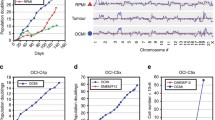Abstract
Human epithelial ovarian tumours were successfully established as xenografts in nude mice in 54% of cases. An evaluation of the biological characteristics of tumours propagated in nude mice was carried out and the functions investigated included morphology, growth kinetics, cellular DNA content, cell surface antigen expression and sensitivity to chemotherapy. To allow a more detailed study of the influence of ploidy on biological behaviour, xenografted tumour with varying degrees of aneuploidy and tumours with a common ancestry but different ploidies were also established. Although this is a highly selective model system favouring the growth of biologically aggressive tumours the xenografts, in general, reflect many of the characteristics of the tumours from which they were derived and are likely to provide a useful model for investigating the biology of ovarian cancer.
Similar content being viewed by others
Rights and permissions
About this article
Cite this article
Friedlander, M., Russell, P., Taylor, I. et al. Ovarian tumour xenografts in the study of the biology of human epithelial ovarian cancer. Br J Cancer 51, 319–333 (1985). https://doi.org/10.1038/bjc.1985.44
Issue Date:
DOI: https://doi.org/10.1038/bjc.1985.44
- Springer Nature Limited
This article is cited by
-
Human ovarian-carcinoma cell lines and companion xenografts: a disease-oriented approach to new platinum anticancer drug discovery
Cancer Chemotherapy and Pharmacology (1992)
-
Carcinoembryonic antigen: Function in metastasis by human colorectal carcinoma
CANCER AND METASTASIS REVIEW (1989)
-
Determination of subcutaneous tumor size in athymic (nude) mice
Cancer Chemotherapy and Pharmacology (1989)
-
Human tumor xenografts as model for drug testing
CANCER AND METASTASIS REVIEW (1988)




